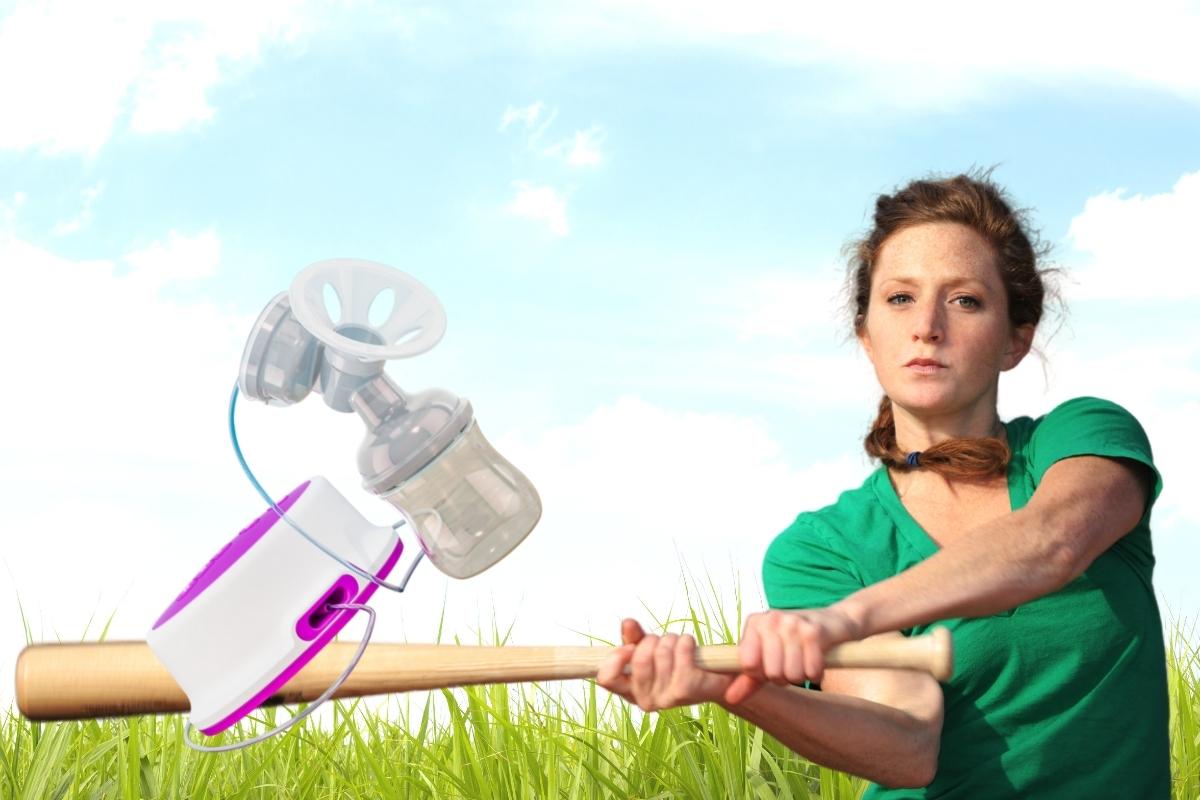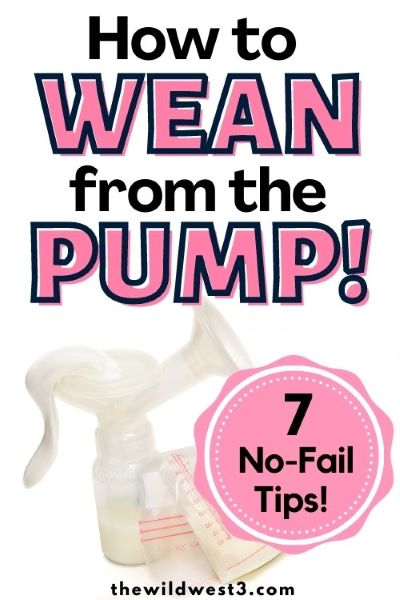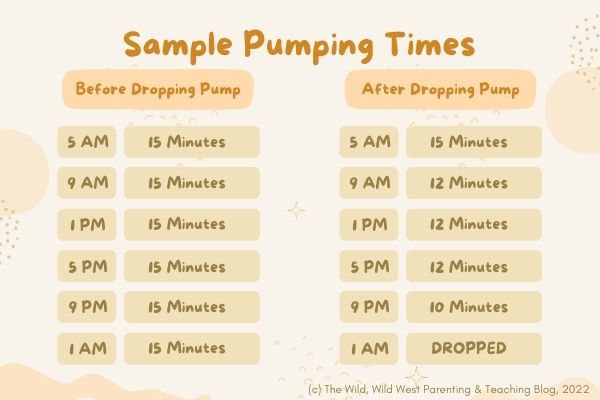
Some women pump breastmilk periodically when they’ll be away from their babies. However, for some women (ahem, me!), called exclusive pumpers, pumping is how they feed their babies all the time.
For exclusive pumpers, ending their breastfeeding journey isn’t about weaning their baby. Instead, EP moms have to decide when and how to wean off the pump.
After exclusively pumping for my four sons, I have a lot of experience in weaning from pumping. If you’re attempting this for the first time, here are seven simple steps to guide you through the process.

1. Set a target date to stop pumping completely
If you want to stop pumping ASAP, like yesterday, you can move on to step 2.
For everyone else – don’t worry if you’re not typically a planner. You can still do this. Simply ask yourself: When would I like to be completely finished pumping (ideally)?
After all, there is no “right” or “wrong” time to stop pumping. The best time to wean from the pump is whenever works best for you. I exclusively pumped for a year, six months, nine months, and three months, depending on the child and particular circumstances.
I pumped for a long time with my third child. Then, I pumped for just a few months with my fourth (thank you, food allergies and unexpected virtual schooling!). Regardless of the duration, the experience of weaning off the pump has been pretty similar each time.
Let’s suppose you’re going on a trip without your breastfed baby. For example, with one of my kids, I was traveling out of state to a wedding. I knew the wedding was eight weeks away, so I made it my goal to be completely weaned from the pump about a week before that.
(Worth noting: If you’re going out of town, of course you don’t need to stop pumping. You can pump and store the milk or pump-and-dump while you’re gone. But I was ready to be done pumping anyway – because exclusively pumping with other kids around is challenging, so the wedding goal made sense to me).
2. Find out how many pumps you need to drop
How many times per day are you pumping right now? That’s the number of pumping sessions you need to eliminate to wean off pumping completely.
You shouldn’t just quit pumping abruptly, because you can end up with clogged ducts or, even worse, mastitis (an infection of the breast). Your body is used to producing and emptying milk on a predictable schedule. As you drop pumps, you want to train your body to produce less milk.
To do this safely and comfortably, you should come up with a schedule to drop your pumps gradually.
3. Divide the number of pumps you need to drop by the amount of time you have
Don’t worry, there’s no complicated math involved here. You just want to drop one pump at a time.
If you need to stop pumping in four weeks (28 days) and you have 3 pumps left to drop (because you’re currently pumping three times per day), you need to drop one pump at least every 9ish days. (28 divided by 3 equals 9.33)
If you need to stop pumping in eight weeks (as I did for the wedding) and you have 7 pumps left to drop, you’ll want to drop one pump at least every 8 days. (56 days divided by 7 pumps equals 8.)
4. Decide: Is that pumping deadline realistic?
The math doesn’t lie. If you have eight pumps to drop in two weeks, that’s not ideal. Personally, I wouldn’t do that if I didn’t have to. I’ve had a million run-ins with clogged ducts and one run-in with mastitis. No thanks.
In my experience, dropping one pump per week is ideal. It gives your body the necessary time to adjust your milk production. It’s certainly possible to stop pumping more quickly — but the key is listening to your body. (More on that later.)
If you have more time than that, you can spread the weaning process out even longer. Alternatively, you can stick to the one pump per week and you’ll actually be fully weaned from the pump before your goal date.
5. If that deadline IS realistic, start weaning off the pump. If it’s not, recalibrate.
{This post may contain affiliate links, which means I may receive a small commission at no additional cost to you if an item is purchased through that link. For more information, click here.*)
If you can drop one pump per week and completely wean from the pump by or before your goal date, hooray! Start dropping pumps (details for the process are at the end of this post).
If you can’t, ideally, set a new goal that is more realistic timewise.
Of course, sometimes you don’t have a lot of choice in the matter. Perhaps you need to wean off pumping because you’re going on a trip that just won’t allow for regular pumping breaks. Maybe you have a medical situation that requires you to stop pumping.
Maybe you just really feel like you can’t take it anymore and you’d rather risk mastitis than keep hooking yourself up to the pump. (In which case, I totally understand where you’re coming from!)
Whatever the reason, if you can’t adjust your date, try to do the best you can to drop pumps as gradually as possible within the confines of your goal.
You may also want to consult your doctor. This isn’t medical advice, but there are prescription and over-the-counter medications that may help your milk supply dry up more quickly. Basically, everything you once did to increase your milk supply? Now, do the opposite.
There’s also no shortage of supplements and teas available online that claim to help with this process. Here are a few widely reviewed and highly rated options (but again, consult your medical provider first!):
- Pink Stork No Flow – This tea comes in individual serving packs and is packed with natural ingredients that are said to inhibit milk production (sage, peppermint, hibiscus, etc.) This one has an excellent rating with nearly 3,000 reviews. It’s priced reasonably as well. They also come in capsules too if, like me, you hate pretty much all tea. Both versions are organic, caffeine-free, and all-natural, which is nice since you probably want to keep using the milk you’re expressing while you’re trying to wean off pumping.
- Earth Mama No More Milk Tea -Like Pink Stork No Flow, this tea is organic, natural, and caffeine-free (and highly rated and reviewed). It works the same way as Pink Stork, so it’s really a matter of price and preference (although I didn’t see a supplement version offered). Just make sure you pick the right version (which is hibiscus sage) — because they offer other tea lines as well (including fennel herb, which helps you produce MORE breast milk!)
- There are also breast creams like Cabo Creme and Tntn Mom’s Cabbage Cream. Lactation consultants frequently recommended cabbage leaves to nursing or pumping women to relieve discomfort from engorgement. I don’t know about you, but I don’t usually have a head of cabbage hanging out in my fridge or freezer. You apply these creams directly to the breast in lieu of cabbage leaves to help minimize discomfort by producing a calming, cooling effect.
6. Shorten your pumping time for the pumping sessions that remain
As you gradually drop pumping sessions (again, suggestions for how to best go about this are at the end), you should also adjust the remainder of your pumping sessions.
If your goal were simply to pump the same amount of milk in fewer pumping sessions, you would want to pump longer during your remaining sessions. That encourages your body to continue making the same amount of milk, just with longer time periods between emptying your breasts.
However, if your goal is to wean off pumping completely, you don’t want to do that. The ultimate goal is to encourage your body to cease milk production altogether. In this case, as you drop complete pumping sessions, you will also try to shorten the pumping sessions that remain in your schedule by a few minutes at a time.
Here’s a graphic showing what this might look like:
If you are dropping your 1 AM pumping session, you’ll probably want to keep the pumping session that comes after that at its normal length (because for at least a few days, there will be excess milk waiting in the following session).
But for the other sessions in the day, particularly the pumping session before the session you’re dropping, you may want to pump for a shorter amount of time. After all, every drop of milk you expel is milk your body will attempt to replace for your baby at future feedings/pumping sessions.
In this illustration, I dropped the middle of the night pumping session. Assuming you’re still doing that, it’s usually the first pump an exclusively pumping mom wants to ditch (for obvious reasons – hello sleep!).
Notice that the next scheduled pump remains the full length. You’ll have excess milk and want to express it. In fact, for me personally, sometimes I even pumped a little longer at the 5 AM/un-eliminated pumping session. It’s not ideal, but comfort is key. If my breasts were still uncomfortably full, I’d rather pump until I was comfortable, even if that meant a little extra time or even slowing the weaning process.
The key with all of this is to listen to your body and do what works for you. Which brings me to my next “step”…
7. LISTEN TO YOUR BODY!
This step should really be steps 1, 2, 3, 4, 5, 6, AND 7. Listening to your body is crucial. It can help you decide when to wean from pumping in the first place and how gradually (or not) to do so.
Your milk production rate, sensitivity to fullness, and tendency toward clogged ducts will all affect the rate at which you can safely and comfortably wean from the pump. And all of those things are unique to you and your body.
How long you’ve been pumping and how old your baby is can also play a role in your experience. For example, if your baby is still pretty young (a few weeks to a few months), your milk supply isn’t as established. Cutting back on pumping sessions could result in a significant loss of output (which is the goal, if you’re weaning).
On the other hand, if you’ve been pumping for a while, your body may simply adjust. You may drop a pumping session and find that your total milk supply remains mostly the same over the course of a 24-hour period. Your body adjusts to the skipped pumping session and just sends out a little more in the remaining sessions.
Don’t worry though. If you’re trying to wean off pumping, as you cut more sessions, eventually, your body will take the hint. You’ll find that you hit a critical point where, as you cut out more pumping sessions, your overall supply will start to decrease.
Tips for continuing to drop pumping sessions (ie total weaning).
As I said earlier, I prefer to drop just one pumping session per week. If your body will tolerate more, feel free to drop your pumps more quickly. Just pay attention to your body and avoid engorgement.
For a while, you’ll probably still pump the same (or very similar) amount of milk as before.
So if you used to pump 30 ounces per day with 6 pumps, and you drop to 5 pumps, you may still find you’re producing 30 ounces (or close to it). After a few days though, you may start to notice the total number of ounces decreases some.
When that happens, that’s a good sign your body is ready to drop another pumping session. Another sign that your body is ready to drop a pumping session is that your breasts are not engorged between sessions.
When you first drop a pumping session, your body continues producing milk, anticipating that it will be emptied. After skipping that session for several days (or, ideally, a week), your body will likely stop producing milk to be emptied at that time.
Continue gradually dropping pumping sessions and shortening the remaining sessions until you’re barely pumping at all. For me, once I was down to pumping just once in the morning and once before bed, my quality of life was so much better. I didn’t have to stress about keeping the baby occupied or trying to hold my baby while I pumped.
At that point, I still wanted to wean, but I didn’t have that same desperate, when-will-this-ever-end feeling. It made it a lot easier to be patient and finish weaning gradually.
To finish out the process of weaning from the pump, I moved to one pump a day for a few days (probably not even the full week). Then I just started waiting as long as I could tolerate between pumping sessions. Sometimes that meant I could go 2 or 3 full days without pumping, and then I’d need to pump for 6 or 7 minutes just to stay comfortable.
At that point, complete weaning is right around the corner. After pumping every 2 or 3 days once or twice, I never had to pump again! Hallelujah!
Frequently Asked Questions About Weaning From the Pump
The 7 steps cover all the basics of weaning from the pump. But, as someone who’s done this several times, newcomers to pumping often ask me the same few questions. I figured I’d put a few of them here in case you have them too.
Which pump should I cut out first?
I prefer to cut out the least convenient pump first. If I’m still pumping at night, that’s always the first pumping session to go.
Which pump should I eliminate last?
For me, the last two pumps to go are always the first of the day and the last of the day. I keep the morning pump for as long as possible because that tends to be my best yielding / highest producing pumping session. I figure, if I’m going to continue being uncomfortable and inconvenienced, I might as well get at least get some more breast milk out of it for my baby.
How do I know if the milk is fully gone?
Honestly, you won’t know for a while. The only way to find out if you’re still producing or holding any residual milk is to try to express some — and why would you want to do that?!
You know the phrase, “Don’t poke the bear”? Well, it applies here. If you’re not feeling full and like you need to pump, don’t! At that point, consider yourself weaned!
How can I stay comfortable while trying to wean off the pump?
Comfort is key! For me, I had to avoid all bras — even my favorite pumping bra — when I was weaning. Wearing them caused clogs for me pretty much every time.
Instead, I wore these snug (but not tight)-fitting nursing camisoles under everything. They kept things under control and minimized any friction without giving me clogged ducts.
I also found holding my baby with full breasts to be pretty uncomfortable. SO, since I knew my youngest was a very difficult baby and required constant holding from 5:00-8:00 PM (and a lot of other times too…), I made sure my late afternoon pump was one of the last ones I cut. This way, they’d be nice and empty for the hours of forced bonding.
Figure out which pumping sessions you hate the most or need the least and cut those first!
I thought I’d successfully weaned off the pump, but now I think I have a clogged duct. Now what?
If you’re feeling comfortable, I wouldn’t worry about it, but watch it. Sometimes you will continue to produce milk and, as time goes by and that milk accumulates, you may notice it in the form of fullness in the breast (or in one spot in the breast).
For me, I was always prone to clogged ducts in one particular spot. Every time I weaned, a few days to a week after my final pump, I’d notice a small lump/clog in that location. It didn’t hurt, but it could be sensitive. I watched, waited, and used heat and compression in the shower, and it resolved after a week or two.
Again, this is not medical advice. But common sense says you should keep an eye on any firm spot or lump. If you notice a fever or you feel ill, it could be mastitis. If it doesn’t resolve, I’d get it checked out, even if it’s not painful. After all, self-breast exams and patient advocacy are key in detecting things like breast cancer in it the early stages.
(No, I’m not trying to make you panic. I’m sure you’re fine. But when in doubt, it’s always best to consult your medical provider!)
What do I do with all my pumping supplies now that I’ve successfully weaned?
Pumping — especially if you were an exclusive pumper — involves a lot of supplies! Pumps, attachments, adapters, covers, pumping bras, milk storage bags, coolers, etc. The list is practically neverending!
And some of it isn’t cheap! When I knew I still wanted more kids, I just packed everything up, labeled it clearly, and stored it in our basement. Once I was nursing again, I hauled it all back up, sanitized it, and voila! It was ready to go again.
When I weaned off the pump for the final time, I knew there’d be no more babies. I gave away everything I could.
A lot of charities won’t take used pumps or pumping supplies because of health concerns. However, many moms are grateful to have a spare on hand. If you’ve ever accidentally left your pump at work or had one die unexpectedly, you know how stressful that can be! Through my local neighborhood share/buy-nothing Facebook groups, I found moms who were happy to take the pumping supplies I was offloading.
Pumping is a journey and so is weaning from the pump
Just like learning to breastfeed or pump can be quite a learning process, weaning is a process too. Make a plan, do your best, and listen to your body. Before long, your body will be your own once again!
Good luck!

